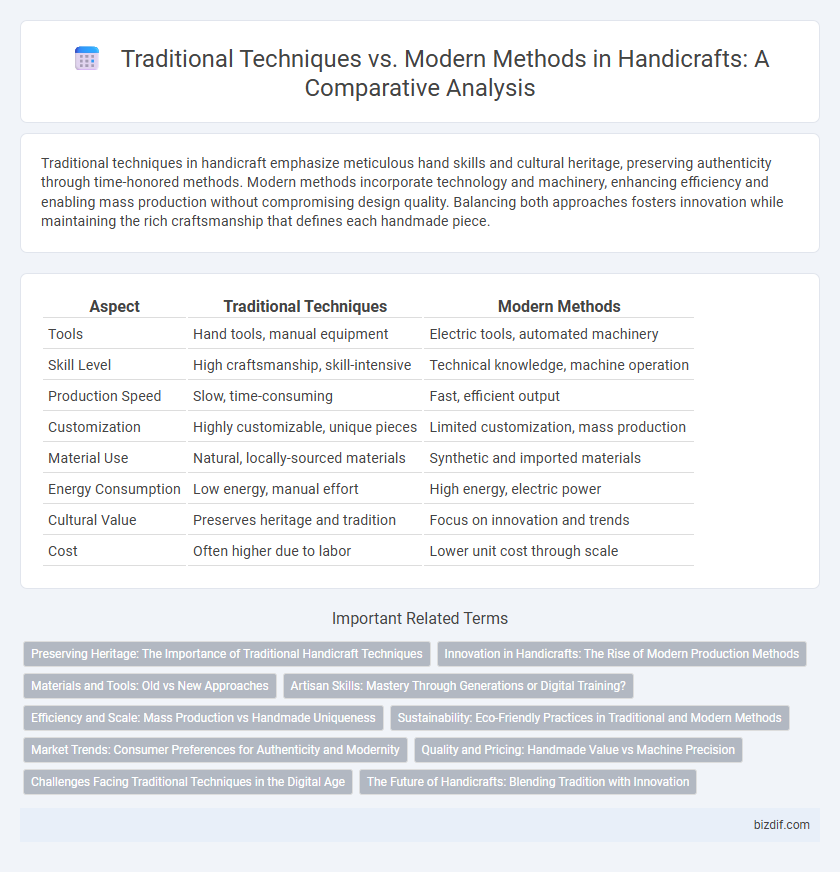Traditional techniques in handicraft emphasize meticulous hand skills and cultural heritage, preserving authenticity through time-honored methods. Modern methods incorporate technology and machinery, enhancing efficiency and enabling mass production without compromising design quality. Balancing both approaches fosters innovation while maintaining the rich craftsmanship that defines each handmade piece.
Table of Comparison
| Aspect | Traditional Techniques | Modern Methods |
|---|---|---|
| Tools | Hand tools, manual equipment | Electric tools, automated machinery |
| Skill Level | High craftsmanship, skill-intensive | Technical knowledge, machine operation |
| Production Speed | Slow, time-consuming | Fast, efficient output |
| Customization | Highly customizable, unique pieces | Limited customization, mass production |
| Material Use | Natural, locally-sourced materials | Synthetic and imported materials |
| Energy Consumption | Low energy, manual effort | High energy, electric power |
| Cultural Value | Preserves heritage and tradition | Focus on innovation and trends |
| Cost | Often higher due to labor | Lower unit cost through scale |
Preserving Heritage: The Importance of Traditional Handicraft Techniques
Traditional handicraft techniques play a crucial role in preserving cultural heritage by maintaining age-old skills and authentic designs passed down through generations. These methods emphasize manual craftsmanship, fostering a deep connection between artisans and their cultural identity, which modern automated processes often overlook. Sustaining traditional practices not only supports local economies but also enriches global diversity by safeguarding unique artistic expressions from being lost in mass production.
Innovation in Handicrafts: The Rise of Modern Production Methods
Modern production methods in handicrafts integrate advanced technologies such as 3D printing and laser cutting to enhance precision and scalability, revolutionizing traditional craftsmanship. These innovative techniques preserve artisanal aesthetics while significantly reducing production time and costs. The convergence of tradition and technology fosters new market opportunities, allowing artisans to reach global audiences with unique, high-quality products.
Materials and Tools: Old vs New Approaches
Traditional handicraft relies heavily on natural materials such as wood, clay, and fibers, shaped using hand tools like chisels, looms, and carving knives that emphasize artisan skill and tactile precision. Modern methods incorporate synthetic materials and power tools, including 3D printers and electric cutters, enhancing efficiency and allowing for mass production with consistent quality. The contrast between these approaches highlights a shift from labor-intensive, material-rooted craftsmanship to technologically-driven processes that prioritize speed and scalability.
Artisan Skills: Mastery Through Generations or Digital Training?
Artisan skills in handicraft are deeply rooted in traditional techniques passed down through generations, emphasizing hands-on experience, cultural heritage, and meticulous craftsmanship that digital training often cannot replicate. Modern methods leverage digital tools and technology to enhance efficiency, precision, and scalability but may risk losing the nuanced artistry and personalized touch inherent in traditional mastery. Balancing generational knowledge with digital innovation ensures the preservation of authentic crafts while embracing contemporary advancements to meet evolving market demands.
Efficiency and Scale: Mass Production vs Handmade Uniqueness
Mass production leverages advanced machinery to enhance efficiency and scale, producing large quantities of handcrafted-inspired products rapidly and uniformly. Traditional techniques emphasize careful, skillful craftsmanship, prioritizing uniqueness and cultural authenticity over volume. While modern methods enable widespread availability, handmade items retain higher perceived value due to their distinct character and artisanal quality.
Sustainability: Eco-Friendly Practices in Traditional and Modern Methods
Traditional handicraft techniques emphasize sustainability by utilizing natural, biodegradable materials such as bamboo, cotton, and natural dyes, which minimize environmental impact and reduce waste. Modern methods increasingly incorporate eco-friendly technologies, including water-based dyes, recycled materials, and energy-efficient machinery, aiming to blend efficiency with environmental responsibility. Both approaches contribute to sustainable craftsmanship by promoting resource conservation and reducing carbon footprints in the production process.
Market Trends: Consumer Preferences for Authenticity and Modernity
Consumers increasingly seek a blend of authenticity and innovation, driving demand for handicrafts that honor traditional techniques while incorporating modern methods. Market trends reveal a growing preference for products that showcase artisanal craftsmanship alongside contemporary design elements. This fusion enhances product appeal, catering to discerning buyers who value both cultural heritage and modern aesthetics.
Quality and Pricing: Handmade Value vs Machine Precision
Traditional handicraft techniques emphasize the unique quality and intricate details that come from handmade items, often resulting in higher perceived value despite longer production times. Modern methods using machine precision boost efficiency and uniformity, significantly reducing costs but sometimes sacrificing the artisanal charm and individuality. Pricing reflects these differences, with handcrafted products commanding premium prices due to their craftsmanship, while machine-made goods offer affordability and consistency for mass markets.
Challenges Facing Traditional Techniques in the Digital Age
Traditional handicraft techniques struggle with declining artisan knowledge due to reduced apprenticeship opportunities and the allure of mass-produced goods created by modern machinery. Limited access to digital marketing platforms hinders the global reach and commercial viability of handmade products. Preservation of cultural heritage faces challenges as younger generations favor contemporary design trends and faster production methods.
The Future of Handicrafts: Blending Tradition with Innovation
Handicrafts are evolving by integrating traditional techniques, such as hand weaving and natural dyeing, with modern methods like 3D printing and digital design software. This fusion enhances craftsmanship quality, broadens creative possibilities, and meets contemporary market demands while preserving cultural heritage. Sustainable materials and innovative production processes are driving the future of handicrafts toward eco-friendly and scalable solutions.
Traditional Techniques vs Modern Methods Infographic

 bizdif.com
bizdif.com